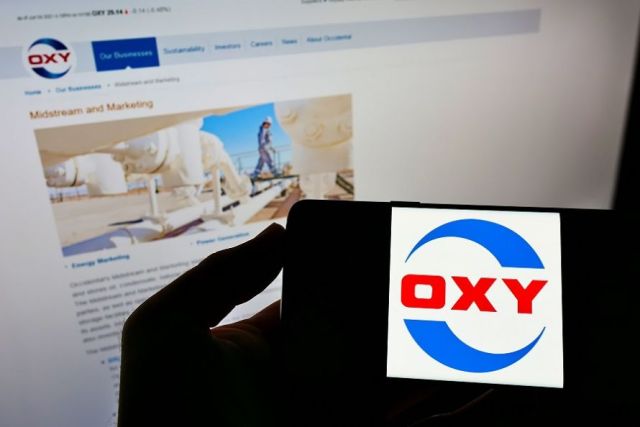
Occidental Petroleum’s direct air capture commercial-scale facility in Texas is designed to capture up to 500,000 metric tons of CO2 annually.(Source: Shutterstock.com)
Occidental Petroleum’s direct air capture (DAC) project, Stratos, is on track to start up in summer 2025, company executives said Aug. 8.
Located on about a 65-acre site in Texas’ Ector County, the commercial-scale facility is designed to capture up to 500,000 metric tons of CO2 annually when it becomes fully operational.
“We’re now moving away from bulk fill. By that I mean putting in the large piping … et cetera into completing the systems one by one. So, we’re at that stage now so that we can commission in the right sequence,” said Kenneth Dillon, senior vice president and president of international oil and gas operations for Occidental. “We get power live this month, which then means we can start getting the control room up and running and testing all of the instrumentation throughout the plant. So, [it’s] going really well at the moment.”
The facility, being developed by Occidental Petroleum’s 1PointFive with Carbon Engineering’s DAC technology, is expected to be one of the largest facilities of its kind.
The facility is among the 130 or so large-scale DAC facilities being developed in the world, according to the International Energy Agency. Despite being on the more expensive side of carbon capture and storage methods, DAC technologies are expected to play a role in global efforts to lower emissions. Currently, only 27 DAC plants have been commissioned worldwide; however, numbers are growing—including in the U.S. where tax incentives are spurring interest.
Tax credits
The carbon sequestration tax credit, known as 45Q, is $17/metric ton for sequestered qualified carbon oxide, but the value jumps to $60 per ton for storage associated with enhanced oil recovery (EOR), $85 per ton for dedicated geologic storage, $130 per ton for DAC with carbon utilization and up to $180 per ton for direct air capture with carbon storage.
CO2 removal credits, which allow companies to fund projects focused on removing carbon, have been instrumental in advancing Stratos. The credits, also called carbon offsets, allow owners to emit a certain amount of CO2 or another greenhouse gas (GHG). Each credit permits one ton of CO2, or other GHG, to be emitted.
In July, 1PointFive said it entered a deal to sell 500,000 metric tons (mt) of Stratos DAC carbon dioxide removal (CDR) credits to tech giant Microsoft over six years.
“The agreement is the largest single purchase of direct air capture CDR credits to date and highlights the increasing recognition of Carbon Engineering technology as a solution to help organizations achieve their net-zero goals,” Occidental CEO Vicki Hollub said on the company’s earnings call Aug. 8.
She later added that Stratos has generated lots of interest from companies around the world.
“We believe that as we prove it up, as we make it better, that it’s going to be much more valuable than what people realize today,” she said.
Richard Jackson, operations president of Occidental’s U.S. onshore resources and carbon management, said the company is monitoring CDR sales and remains optimistic on the outlook for that market. However, it hasn’t set any specific parameters on CDR targets though it will be a major component of FID criteria for DAC projects.
Cost down
Innovative techniques seen during construction are providing line of sight to cost down, Occidental executives said. The DAC process utilizes a liquid sorbent. Some of the materials used in the process—such as potassium hydroxide and decomposed calcium oxide pellets—can be reused.
“We are seeing really great potential for performance improvements and cost down improvements, and we’re looking at how to incorporate these learnings as quickly as possible,” Dillon said. “Companies like Technip Energies are also focused on how to achieve cost down for their equipment, and that’s driven from the top of the company. So, we’re getting great support from our visionary vendors who have bought into long-term DAC future.”
1PointFive is also developing the South Texas DAC hub in partnership with King Ranch, Carbon Engineering and Worley in South Texas. The DAC facility landed funding from the U.S. Department of Energy.
“King Ranch is really what we’ve targeted for the next kind of development beyond the Permian. And it really has a lot of scale advantages that we’ve talked about in the past, both with the subsurface and as we think about it at the balance of plant,” Jackson said. “Think about key power inputs, emission-free power inputs, water or other advantages,” he said, adding subsurface engineering work continues.
Plans are to incorporate learnings from Stratos, Oxy’s first DAC project, to other projects.
“The exciting part about that King Ranch development [is that it’s] a 30 million ton per year hub,” Jackson said. “And so, you get these tremendous economies of scale that we really think add to the R&D improvements in terms of a cost down.”
RELATED
Occidental’s 1PointFive Agrees to Sell Carbon Credits to Microsoft
Occidental, Battelle-led DAC Projects Land Up To $1.2 Billion in Funding From US
Recommended Reading
Comments
Add new comment
This conversation is moderated according to Hart Energy community rules. Please read the rules before joining the discussion. If you’re experiencing any technical problems, please contact our customer care team.

